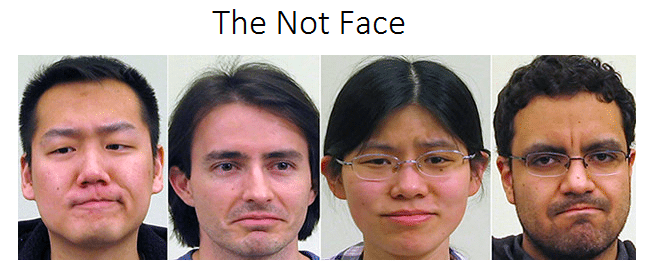One of the easiest ways to avoid miscommunication is to know when people disagree with you. In the past, this was nearly impossible to achieve because many people avoided sharing their negative opinions directly but recently, researchers discovered a new microexpression known as the “not face” that is a reliable indicator someone disagrees with, disapproves of or otherwise thinks negatively of something.
A microexpression is a brief, involuntary response to feeling an intense emotion.

There are 7 universal microexpressions that convey the most fundamental human emotions:
- Anger
- Fear
- Sadness
- Surprise
- Disgust
- Contempt
- Happiness
Though our brains subconsciously notice microexpressions and pick up on their emotions, being able to read them allows you to consciously understand what people are feeling and adjust your speech and behaviors based on that.
The Not Face was discovered in 2016 by researchers at Ohio University. What’s unique about its appearance is that it’s actually a combination of 3 other microexpressions: disgust, contempt and anger and indicates negation, disapproval and disagreement.
Look familiar? Have you seen this face on colleagues or friends? According to researchers, you’ve probably seen it more than you think.
The Science Behind the Expression
If science is your thing, let’s dive into the research. If not, feel free to skip to the next section to learn how knowing the not face can benefit you at work and in your personal life.
The Study:
158 Ohio State students were brought into the lab. These students spoke a variety of languages (English, Spanish, Mandarin Chinese and American Sign Language [ASL]). When studying microexpressions, it’s important to include individuals whose languages have evolved from different grammatical and regional structures. This ensures that that expression can be dubbed as ‘universal’ rather than unique to a specific culture or group of people.
The students were placed in front of a camera one by one. They were video recorded and photographed as they had a conversation with the person behind the camera, who spoke to them in their native language.
What the researchers were trying to identify was a facial expression that determines the grammatical function of a sentence, known as a “grammatical marker.” For instance, let’s take the phrase, “I am not eating this cake.” “Not” is the grammatical marker here. Because without it, the meaning of the sentence completely changes to “I am eating this cake.”
The researchers hypothesized that if all the participants made a similar expression when using that grammatical marker, the grammatical marker for negation is universal.
The students were then given one of two tasks. They were asked to answer questions that were likely to result in disagreement, such as “A study shows that tuition should increase 30 percent. What do you think?” Or they had to memorize and repeat negative sentences that were written ahead of time by the researchers.
The Results
Grammatical markers of negation were identified in all four language groups. The researchers marked every frame of the videos of the students in order to identify the directions in which their facial muscles moved as they spoke. The result was thousands of frames. Computer algorithms then parsed through these frames to find similarities between them.
The researchers first used the algorithms to identify 21 different facial expressions. Some of them were combinations of expressions. For instance, happiness and disgust could combine into a “happy disgusted” facial expression, a face someone might make when watching a horror comedy.
The team had a specific focus on negative expressions, going in accordance with a Charles Darwin belief that our ability to communicate aggression or danger was key to our survival long before we were able to communicate using languages. The researchers reasoned that an expression for disagreement would be the easiest to identify if universal facial expressions exist.
And this expression for disagreement was found.
The students in all four groups displayed the same three muscle movements when verbalizing a grammatical marker of negation: the raised chin of the disgust expression, the furrowed brows of the anger expression and the pressed together lips of contempt.
Researchers then gave the expression a name: the “Not Face.”
An interesting fact about the Not Face is that it is regularly used in American Sign Language. Sometimes, people who can speak ASL will use the Not Face instead of the sign for no or disagreement. This goes to show the universality of the expression. This is the first time that scientists have found an expression that replaces an actual word in American Sign Language.
“This facial expression not only exists, but in some instances, it is the only marker of negation in a signed sentence,” lead researcher Martinez said. “Sometimes the only way you can tell that the meaning of the sentence is negative is that person made the ‘not face’ when they signed it.” (“Signing” here is referring to sign language).
Reading the Not Face in the Workplace
As a leader being able to identify the not face in your subordinates can help you notice and act upon employee dissatisfaction before it leads to behavioral problems that from disengagement. It’s estimated that 52% of employees in the United States are disengaged – meaning they show up to work and do the bare minimum to not get fired because they dislike their work, disagree with their manager/company, or lack a sense of purpose and pride in their work. This lack of engagement has huge financial impacts because employees fail to produce at optimal levels and are less willing and able to innovate and adapt to change.
If you see the not face expression flash on an employee’s face but they do not make an effort to verbalize their thoughts, insist on hearing their opinions and let them know that it is okay if they disagree. You need to find out what triggered the expression so you can take actions to mitigate their negativity and reduce the likelihood of them disengaging over reasons that are unknown to you.
On the other hand, if you are an employee, you can look for the not face expression on your supervisor’s face to get additional feedback from them. Harvard Business Review reports that nearly 40% of managers feel uncomfortable giving their employees negative feedback and often avoid doing so. If you have one of those managers, being able to recognize the not face and the universal facial expressions in general can help you pick up on the thoughts that they aren’t sharing with you. For example, in a meeting where you are explaining how you want do a project and you see the not face flash, you know that they disagree with whatever you just said and you need to come up with an alternative plan of action to fully please them.
Uncover Hidden Negativity in Your Relationships
Like in the workplace, many people don’t feel comfortable verbally expressing their disagreement and negative opinions in their personal lives. This can cause resentment to build up because if you don’t know if your friends and other people you hang out with disagreeing with or otherwise displaying negativity towards you, you can’t address those issues.
Warning: When identifying the not face in your personal life it is crucial that you pay attention to context. It could be that your friend who constantly flashes the not face thinks highly of you and is a loyal friend but the two of you talk politics a lot and their facial expression is in response to the topics of your conversations not you directly. The not face is only concerning when, on a regular basis, it flashes when you are speaking about subjects that should not trigger a negative response.
If the latter is the case, ask them more questions to understand the source of their negativity. Something seemingly inconsequential could bring up bad memories for them or they could be going through a tough time and haven’t revealed that too you. Or they might be a generally negative person. The conversations you have post spotting several instances of the not face can reveal who in your life needs extra support and who you should distance yourself from.
Learn the 5 scientifically proven steps to being a lie detector in our online training. Never miss a lie again. You’ll be able to spot deception and uncover hidden emotions, and unlock the secret language of lies.

